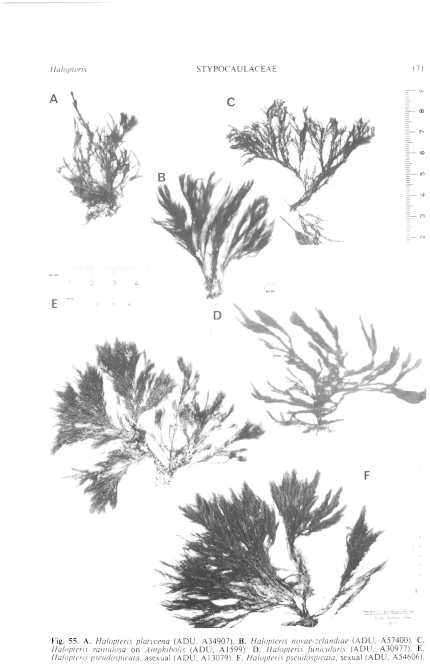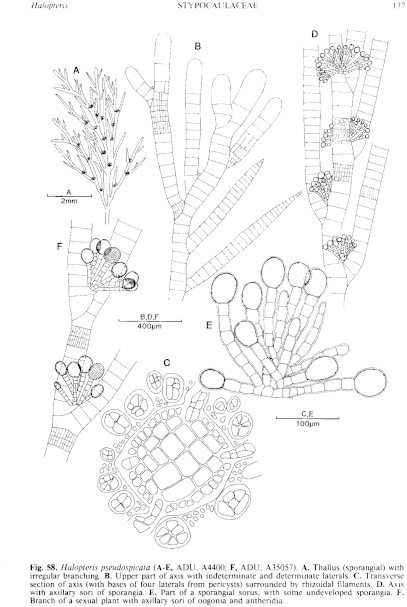|
|
|
|
|
|||||||||||
|
Electronic Flora of South Australia Species Fact Sheet
Phylum Phaeophyta – Order Sphacelariales – Family Stypocaulaceae
Selected citations: Womersley 1967: 204.
Synonym
H. brachycarpa Sauvageau 1904: 404, fig. 81. Lindauer et al. 1961: 166, fig. 19(5–9) (?). Moore 1951: 266, figs 5, 6, 26.
Thallus (Fig. 55E,F) dark brown, (3–) 6–20 (–25) cm long, densely tufted with a rhizoidal holdfast 3–15 mm across and one to several erect, much branched axes, with adventitious laterals from mid and lower parts of axes, which often become denuded, usually epilithic. Branching (Fig. 58A,B) of several orders, irregularly radial with laterals every (345–10 (–20) segments, with lesser laterals determinate and tapering to a point; mid (sometimes upper) and lower axes producing descending rhizoids which corticate the axes and form the holdfast; phaeophycean hairs absent. Axes (Fig. 58B,C) 160–220 µm in diameter with segments L/B 0.7–1.0, corticated by a layer of small, rectangular cells (without secondary cortex); primary laterals 100–140 µm in diameter with segments L/B 0.6–0.8 (–1.0); ultimate laterals (Fig. 58B) 80–120 µ in diameter near their bases with segments L/B 0.4–0.6 (–0.8); rhizoids arising from pericysts.
Reproduction: Unilocular sporangia (Fig. 58D,E) in dense sori (150–250 µm radius) in axils of numerous consecutive laterals separated by (usually) 1–2 (–3) soral diameters, each with a dense hemispherical mass of sporangia on simple or branched pedicels 2–7 cells long, with the sporangia at an even height, and without sterile paraphyses; sporangia subspherical, 40–50 µm in diameter. Sexual plants (Fig. 58F) with mixed clusters of oogonia and antheridia in axils of laterals, borne on unbranched or basally branched pedicels 4–8 segments long, with occasional longitudinal divisions; oogonia subspherical, 65–110 µm in diameter; antheridia subspherical, less common than oogonia, 60–100 µm in diameter.
Type from Cape Riche, W.Aust. (Harvey, Trav. set 297); in TCD.
Selected specimens: Elliston, S. Aust., 10–11 m deep (Shepherd, 20.x.1969; ADU, A35057, sexual). Pennington Bay, Kangaroo I., S. Aust. rear eulittoral (Womersley, 6.i.1947; ADU, A4400). Off Cape Jervis, S. Aust., 10–12 m deep (Shepherd, 29.xi,1983; ADU, A54606, sexual). Victor Harbor, S. Aust., drift (Womersley, 12.vi.1950; ADU, A13079). Peterborough, Vic., drift (Pope & Bennett, 17.viii.1949; ADU, Al2166). Greens Beach, N. Tas., drift ( Womersley, 9.xi.1982; ADU, A55576).
Taxonomic notes: Distribution. From King George Sound, W. Aust. around southern Australia to Point Dromedary, N.S.W. and around Tasmania.
New Zealand?
Moore (1951, p. 266) and Lindauer et al. (1961, p. 166) recorded H. brachycarpa from New Zealand, preferring to use this name rather than H. pseudospicata published by Sauvageau at the same time. Since the latter name applies to sporangial plants and H. brachycarpa to sexual plants, and the sporangial plants are far commoner than the sexual ones, it seems preferable to use the name H. pseudospicata. The figures of Lindauer et al. (1961, fig. 19, 5–9) however do not agree well with H. pseudospicata, especially in the opposite branching (p. 166 and fig. 5) which is reported as distichous above, and in the branched pedicels of the sporangia. The New Zealand plant may well be distinct from the Australian.
The type (in C) of H. brachycarpa is Harvey, Alg. Aust. Exsicc. 105D from Port Fairy, Vic., and an isotype (Harvey, Trav. Set 297) is in MEL, 559621.
H. pseudospicata is very similar in habit and thallus structure to H. funicularis, differing essentially in the reproductive organs. The (often) closely adjacent, hemispherical, masses of unilocular sporangia are distinctive in most plants, whereas those of H..funicularis are more separated and the sort are more irregular in appearance, with looser sporangium-bearing pedicels accompanied by curved, clavate paraphyses. The sex organs in H. pseudospicata are confined to the axils on simple pedicels, whereas in H. filnicularis they arise adventitiously from the laterals as well as on branched axillary systems.
References:
LINDAUER, V.W., CHAPMAN, V.J. & AIKEN, M. (1961). The marine algae of New Zealand. II. Phaeophyceae. Nova Hedwigia 3, 129–350, Plates 57–97.
MOORE, L.B. (1951). Reproduction in Halopteris (Sphacelariales). Ann. Bot., N.S., 15, 265–278.
WOMERSLEY, H.B.S. (1967). A critical survey of the marine algae of southern Australia. II. Phaeophyta. Aust. J. Bot. 15, 189–270.
The Marine Benthic Flora of Southern Australia Part II complete list of references.
Publication:
Womersley, H.B.S. (14 December, 1987)
The Marine Benthic Flora of Southern Australia
Part II
©Board of the Botanic Gardens and State Herbarium, Government of South Australia
Illustrations in Womersley Part II, 1997: FIGS 55E,F, 58.

Figure 55 enlarge
Fig. 55. A. Halopteris platycena (ADU, A34907). B. Halopteris novae-zelandiae (ADU, A57400). C. Halopteris ramulosa on Amphibolis (ADU, A 1599). D. Halopteris funicularis (ADU, A30977). E. Halopteris pseudospicata, asexual (ADU, A13079). F. Halopteris pseudospicata, sexual (ADU, A54606).

Figure 58 enlarge
Fig. 58. Halopteris pseudospicata (A–E, ADU, A4400; F, ADU, A35057). A. Thallus (sporangial) with irregular branching. B. Upper part of axis with indeterminate and determinate laterals. C. Transverse section of axis (with bases of four laterals from pericysts) surrounded by rhizoidal filaments. D. Axis with axillary sori of sporangia. E. Part of a sporangial sorus, with some undeveloped sporangia. F. Branch of a sexual plant with axillary sori of oogonia and antheridia.

|
Email Contact: State Herbarium of South Australia |

|